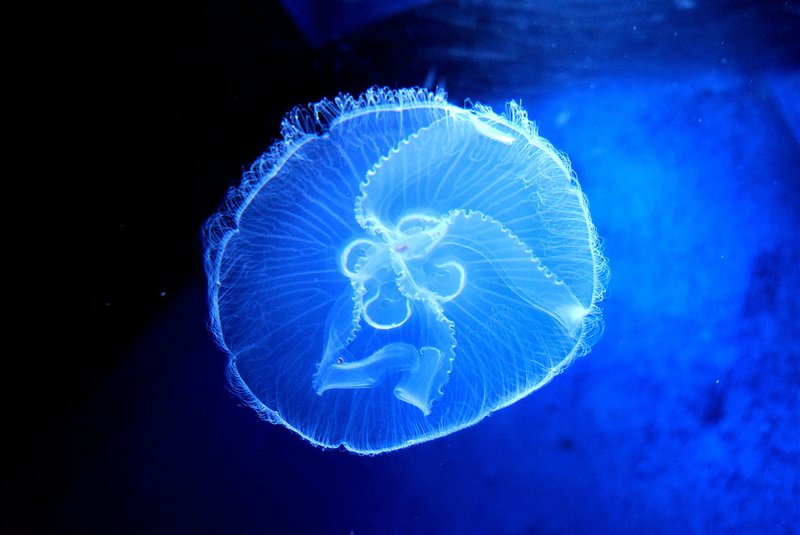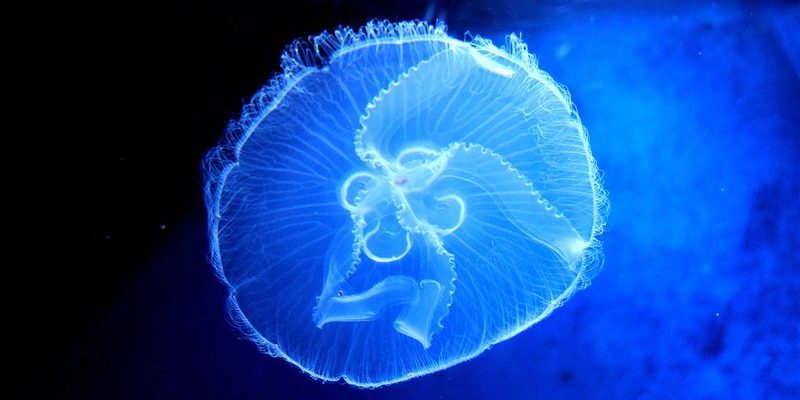
Moon jellyfish, scientifically known as *Aurelia aurita*, are found in oceans all over the world and thrive in various water conditions. Their soft, gelatinous bodies can be quite harmless to humans but offer a wealth of insight into marine life. So, let’s dive deeper into the ocean’s wonders and explore ten captivating facts about moon jellyfish that might surprise you.
1. The Anatomy of a Moon Jellyfish
Moon jellyfish have a unique and simple anatomy that sets them apart from most marine animals. Unlike fish, they lack a centralized brain, heart, or bones. Instead, their bodies are made up of a soft, gelatinous substance called mesoglea, which accounts for about 95% of their weight! This squishy layer allows them to float effortlessly in the water, much like a balloon bobbing in the air.
Their bell-shaped body, which can be up to 40 centimeters (about 16 inches) in diameter, has tentacles that hang down. These tentacles are equipped with specialized cells called nematocysts, which help them capture prey like plankton and small fish. If you’ve ever seen one pulse and contract, you might think of it as a rhythmic heartbeat, although they don’t actually have one.
Notably, you might be surprised to learn that moon jellyfish can also change their color. Depending on their environment and light exposure, they may appear in shades of blue, pink, or even yellow!
2. Lifespan and Reproduction
You might be wondering how long these captivating creatures live. On average, moon jellyfish live around one to three years, depending on environmental conditions. Their life cycle is quite fascinating and includes both sexual and asexual reproduction.
During their life, moon jellyfish go through several stages. They start as eggs, which develop into larvae called planulae. These larvae eventually settle on the ocean floor and grow into polyps. The polyps can reproduce asexually, creating new jellyfish that will eventually break off and swim away. It’s like a continuous cycle of renewal that ensures the survival of their species, even in challenging conditions.
When the jellyfish reach maturity, they can reproduce sexually, releasing sperm and eggs into the water. This process often leads to breathtaking blooms of jellyfish, turning parts of the ocean into stunning spectacles!
3. They’re Mostly Made of Water
Here’s the thing about moon jellyfish: they’re practically water! Composed of about 95% water, they have one of the highest water content of any animal on the planet. This watery structure helps them maintain buoyancy and enables them to float seamlessly through their aquatic environments.
This high water content is also a reason why they can be so delicate. Just a small bump or shift in currents can send a moon jellyfish tumbling through the ocean. So, when you see them washed up on the beach, it’s not just because of an unusual tide; it’s often a result of their fragile nature in the aquatic ecosystem.
4. Their Diet is Mostly Plankton
You might find it surprising to learn that moon jellyfish primarily feast on tiny organisms like plankton, small fish larvae, and even other jellyfish. Their feeding method is quite passive and relies on their tentacles to catch food as it drifts by.
The nematocysts on their tentacles release venom when they come into contact with prey. While this might sound scary, don’t worry—moon jellyfish have a mild sting that is mostly harmless to humans. In fact, many beachgoers have seen them without even realizing they were near a jellyfish!
Think of them as the vacuum cleaners of the ocean, scooping up little bits of food without much effort. This feeding method helps maintain the balance of marine ecosystems by controlling plankton populations.
5. Moon Jellyfish Can Glow
You might be amazed to know that moon jellyfish have the ability to bioluminesce. This means they can produce their own light, creating an enchanting glow that’s truly a sight to behold. While this phenomenon is most often seen in dark waters, it can also occur when they’re disturbed.
This ability to glow serves multiple purposes. For one, it can help deter predators by causing confusion in the water. Imagine a sudden burst of light in the night— it might just startle a predator enough to give the jellyfish a chance to escape!
Moreover, bioluminescence plays a role in attracting mates. During mating season, the glow can serve as a signal to potential partners, lighting up the ocean like stars twinkling in the sky.
6. They Play a Role in Marine Ecosystems
Moon jellyfish are not just mesmerizing; they also play a crucial role in marine ecosystems. As both predators and prey, they help maintain the balance in their environment. By feeding on plankton, they regulate tiny animal populations, ensuring that no single species overwhelms the ecosystem.
Additionally, they are a food source for various marine animals, including sea turtles, sunfish, and some species of fish. This relationship highlights the interconnectedness of ocean life—each species plays a part in the intricate web of the marine environment.
You could think of moon jellyfish as nature’s balancing act, keeping the ocean’s food web in check while adding beauty to the underwater world.
7. Their Habitat is Quite Diverse
Moon jellyfish aren’t picky about where they live. They can be found in a variety of habitats around the globe, from warm coastal waters to colder regions. These adaptable creatures thrive in everything from brackish waters to the open ocean, showcasing their versatility.
In fact, you might spot them in harbors, bays, and even estuaries. They are often drawn to areas where food is plentiful, which is why you might see them congregating in certain spots. So, if you’re near the ocean, keep your eyes peeled. You never know when you might encounter a floaty moon jellyfish!
8. They Have a Unique Relationship with Other Species
One of the more surprising facts about moon jellyfish is their symbiotic relationships with other marine organisms. One of the most fascinating examples is their association with small fish, such as clownfish or certain species of shrimp.
These little fish find refuge among the jellyfish’s tentacles, which provides them protection from predators while offering the jellyfish some cleaning services in return. It’s a win-win situation that shows how different species can benefit from one another.
This relationship illustrates the cooperative side of nature. In the vast ocean, collaboration often leads to survival, and moon jellyfish exemplify this perfectly.
9. They’re a Source of Inspiration
Moon jellyfish have not only inspired marine biologists but artists and designers as well. Their graceful movements and beautiful appearance make them popular subjects in art, fashion, and even technology.
Many designers take cues from the jellyfish’s shape and bioluminescence, creating stunning pieces that mimic the ocean’s beauty. Artists have painted them, photographed them, and even created sculptures inspired by their unique forms.
Their beauty is a reminder of how nature can inspire creativity in unexpected ways. You might even find jellyfish themes in popular culture, like movies and animations, showcasing their lasting impact on our imaginations.
10. Conservation and Environmental Impact
As enchanting as they are, moon jellyfish face threats from changing ocean conditions due to climate change. Rising temperatures and changing salinity levels can influence their populations, leading to blooms that disrupt marine ecosystems.
Conservation efforts are vital to understanding these jellyfish and ensuring their survival. Protecting ocean habitats is crucial, not just for moon jellyfish but for all marine life dependent on healthy ecosystems.
Individuals can contribute to these efforts by supporting ocean-friendly initiatives, reducing plastic waste, and advocating for cleaner oceans. Every small action counts, and together, we can help maintain the beauty and balance of our oceans.
As you can see, moon jellyfish are more than just pretty creatures floating in the water. They embody the complexity and beauty of marine life, reminding us of the importance of understanding and preserving our oceans. Next time you see one, take a moment to appreciate the intricate dance of nature they represent!

